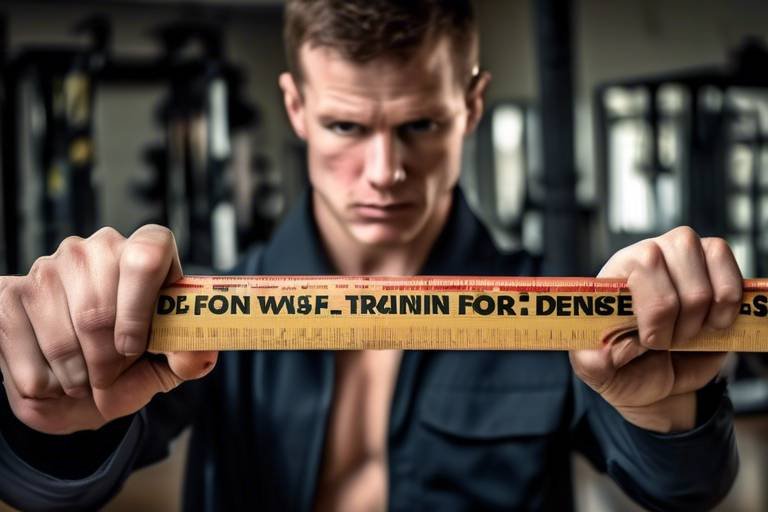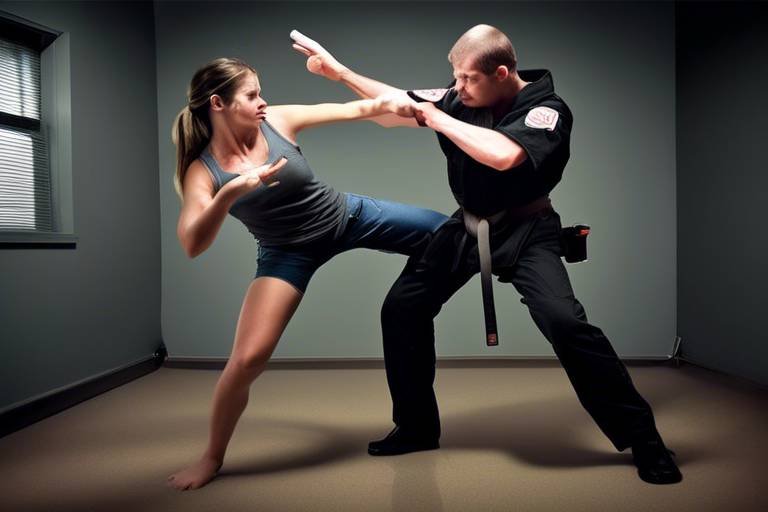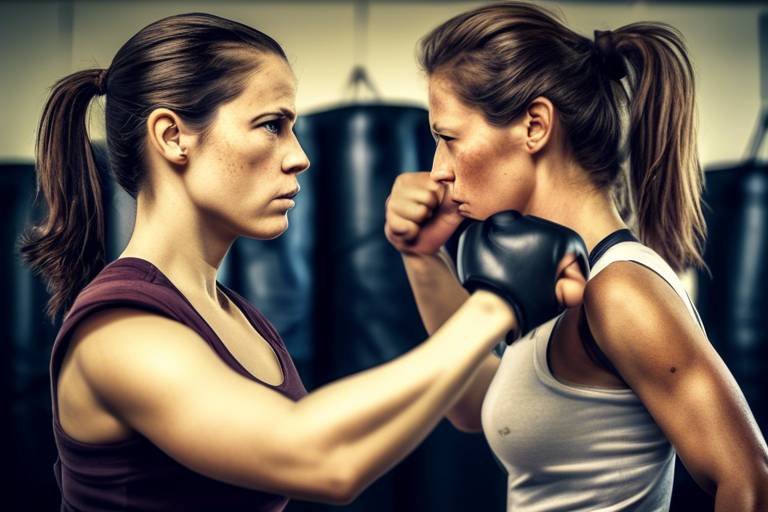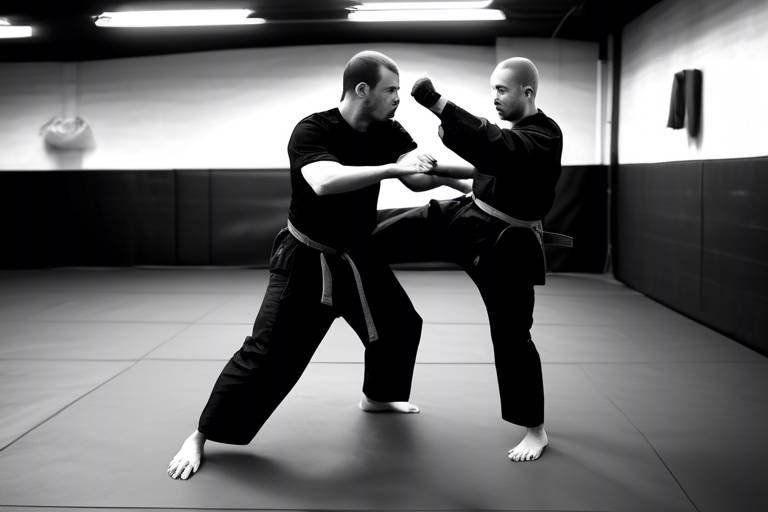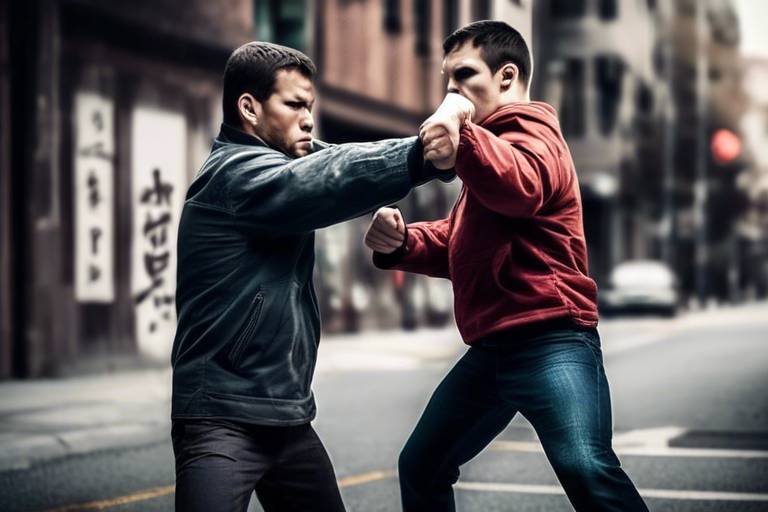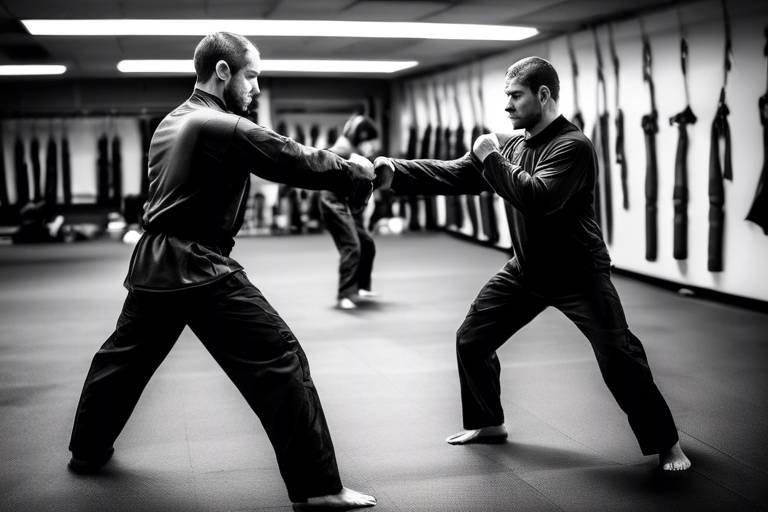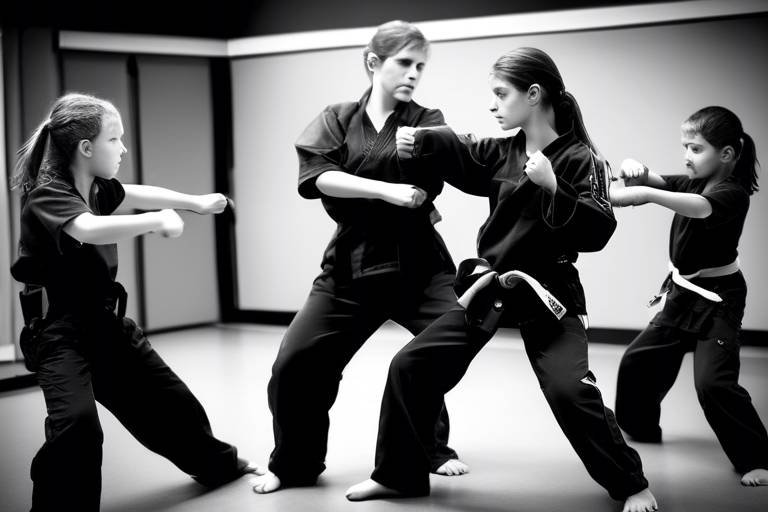Yardstick for Evaluating the Efficacy of Your Self-Defense Training
In today's world, where personal safety is a growing concern, having a reliable method to evaluate the efficacy of your self-defense training is paramount. The yardstick for measuring your skills goes beyond just knowing a few techniques; it encompasses a comprehensive understanding of how well you can apply those techniques in real-life scenarios. Think of it as a test drive for your skills—just like you wouldn’t buy a car without taking it for a spin, you shouldn't rely solely on class attendance or knowledge of moves without assessing your readiness to use them under pressure.
Evaluating self-defense training involves several critical components. First and foremost, it's essential to understand the underlying principles of self-defense. This foundational knowledge serves as a framework for all techniques you learn. Without this, you might find yourself floundering in a real confrontation, unsure of how to react. Additionally, setting measurable goals can help you track your progress over time. When you know what you're aiming for, it becomes easier to see how far you've come and where you need to focus your efforts.
Engaging in practical application scenarios is another vital aspect of this evaluation process. These scenarios allow you to put your skills to the test in controlled environments, simulating the unpredictability of a real confrontation. Imagine practicing a self-defense move against a partner who is fully resisting; this is where the rubber meets the road. It’s not just about executing a technique; it’s about adapting and responding in the moment, which is where true skill is honed.
Moreover, skill retention techniques play a crucial role in ensuring that the skills you learn remain sharp over time. It’s all too easy to forget techniques if they aren’t practiced regularly. Incorporating drills that reinforce muscle memory can be a game-changer. Think of it like riding a bike; once you learn, you never really forget, but you do need to practice occasionally to stay proficient. This is particularly important when it comes to self-defense, where the stakes are high, and every second counts.
Feedback from instructors can also enhance your training effectiveness. Constructive criticism is invaluable, as it helps you identify both strengths and areas for improvement. After all, no one is perfect, and even the best practitioners can benefit from a fresh perspective. Similarly, peer evaluations and sparring sessions provide insights into your abilities. Training with partners allows you to adapt your techniques to different styles and situations, broadening your skill set and enhancing your adaptability.
Ultimately, the real test of your skills lies in real-life scenarios. Safely recreating high-pressure situations can help gauge your preparedness and response effectiveness. It’s one thing to practice techniques in a controlled environment; it’s another to apply them when adrenaline is pumping and the stakes are real. By simulating these experiences, you can better prepare yourself for potential confrontations.
Lastly, monitoring your progress over time is essential for understanding your growth in self-defense training. Keeping a journal, using video analysis, or conducting performance assessments can provide tangible evidence of your improvement. This ongoing evaluation helps you stay motivated and focused on your goals. Additionally, self-defense training must evolve to address new challenges and threats. Staying informed about emerging techniques and adapting your training regimen accordingly is crucial for maintaining relevance in an ever-changing world.
- How often should I practice my self-defense techniques?
Regular practice is key. Aim for at least once a week, but daily drills can significantly enhance retention. - What should I do if I feel unprepared in a real situation?
Focus on your breathing, remember your training, and trust your instincts. Consider seeking additional training if you feel consistently unprepared. - Can I train for self-defense alone?
While solo practice can help with technique, training with partners is crucial for developing adaptability and real-world application.

Understanding Self-Defense Principles
Understanding the principles of self-defense is like having a solid foundation before building a house. Without that foundation, everything you construct is at risk of collapsing. Self-defense isn't just about throwing punches or executing flashy moves; it's about awareness, timing, and strategy. These elements intertwine to create a comprehensive approach to personal safety that can be applied in real-life situations.
At its core, self-defense is based on the idea of protecting oneself from harm. This means that the first principle is to recognize potential threats before they escalate. Imagine walking down the street and feeling someone following you. The ability to identify that discomfort and take action—whether by changing your route or seeking help—is a fundamental self-defense skill. This awareness can often prevent confrontations before they even begin.
Another critical principle is proportional response. Self-defense laws vary by location, but generally, you are allowed to use reasonable force to protect yourself. This means that if someone shoves you, responding with a punch might be excessive. Understanding what constitutes reasonable force in your area is crucial, as it can affect legal outcomes if you ever find yourself in a situation where you need to defend yourself.
Additionally, self-defense training emphasizes the importance of technique over strength. Many people believe that being physically strong is the key to defending oneself, but this is a misconception. In reality, effective self-defense techniques often rely on leverage, timing, and body mechanics rather than brute force. For instance, a well-executed joint lock can immobilize a larger opponent without requiring significant strength. This is why practicing techniques against partners of varying sizes and strengths is essential.
Moreover, self-defense is not just about physical techniques; it's also about mental preparedness. The psychological aspect of self-defense can be just as important as the physical. This includes being able to stay calm under pressure, recognizing when to fight and when to flee, and having the confidence to assert oneself in a threatening situation. Training your mind to respond effectively can make a significant difference in how you react when faced with danger.
Incorporating these principles into your training regimen can enhance your effectiveness in real-world scenarios. Here’s a quick overview of self-defense principles to keep in mind:
| Principle | Description |
|---|---|
| Awareness | Recognizing potential threats and avoiding dangerous situations. |
| Proportional Response | Using appropriate force based on the level of threat. |
| Technique Over Strength | Utilizing effective techniques that rely on skill rather than physical power. |
| Mental Preparedness | Staying calm and confident in high-pressure situations. |
In summary, understanding these self-defense principles lays the groundwork for effective training. By focusing on awareness, appropriate responses, and the importance of both physical and mental preparation, individuals can cultivate the skills necessary to protect themselves confidently. So, next time you step onto the mat or into the dojo, remember that every punch, kick, or block is built upon these fundamental ideas.

Setting Measurable Goals
When it comes to self-defense training, is like having a roadmap for your journey. Without clear objectives, you might find yourself wandering aimlessly, unsure of your progress or what to focus on next. So, how do you establish these goals? Start by asking yourself what you want to achieve. Are you aiming to improve your striking techniques, enhance your situational awareness, or perhaps increase your overall fitness level? Each of these objectives can be broken down into specific, measurable goals that will help you stay on track.
For instance, instead of saying, “I want to get better at self-defense,” you could set a goal like, “I want to learn and master five new techniques in the next three months.” This goal is not only specific but also time-bound, making it easier to evaluate your progress. As you work through your training, it’s essential to regularly review these goals to ensure they remain relevant and challenging. If you find that you’re breezing through your objectives, don’t hesitate to raise the bar!
Another effective strategy for setting measurable goals is to utilize the SMART criteria, which stands for Specific, Measurable, Achievable, Relevant, and Time-bound. Here’s a quick breakdown:
| SMART Criteria | Description |
|---|---|
| Specific | Your goal should be clear and specific. Instead of vague objectives, define exactly what you want to accomplish. |
| Measurable | Include criteria that allow you to measure your progress. This could be the number of techniques learned or the frequency of practice sessions. |
| Achievable | Your goal should be realistic and attainable, considering your current skill level and available resources. |
| Relevant | Ensure that your goals align with your overall self-defense aspirations and personal safety needs. |
| Time-bound | Set a deadline for your goals to create a sense of urgency and keep you motivated. |
By applying the SMART framework, you can create a structured plan that not only keeps you motivated but also allows you to see tangible results over time. Additionally, don’t forget to celebrate your achievements, no matter how small they may seem. Recognizing your progress can boost your confidence and encourage you to keep pushing forward.
Incorporating regular assessments into your training routine is also crucial. Consider keeping a training journal where you can document your goals, progress, and any challenges you encounter along the way. This practice not only helps you stay accountable but also provides valuable insights into your development. Remember, self-defense training is a journey, and having measurable goals will guide you along the way!
- How often should I review my self-defense goals? It's beneficial to review your goals at least once a month to ensure they remain relevant and challenging.
- What if I don’t meet my goals? Don’t be discouraged! Use it as a learning experience to adjust your strategies and set new, more realistic goals.
- Can I set goals with a training partner? Absolutely! Collaborating with a partner can provide motivation and accountability, making the process more enjoyable.

Practical Application Scenarios
Engaging in is a crucial step in assessing the effectiveness of your self-defense training. Imagine being in a real-life confrontation; the adrenaline is pumping, and your instincts kick in. This is where the rubber meets the road. To prepare for such situations, it’s essential to simulate various scenarios that might occur in everyday life. By doing so, you can test your skills in a controlled environment, allowing you to identify strengths and weaknesses in your techniques.
One effective way to create these scenarios is through structured drills. For instance, consider practicing different types of attacks, such as grabs, punches, or even surprise assaults. By replicating these situations, you can develop a better understanding of how to respond effectively. Here are a few examples of practical application scenarios that you might find beneficial:
- Controlled Sparring Sessions: Engage in sparring with a partner where one person plays the role of the attacker and the other defends. This dynamic not only helps in practicing techniques but also in developing timing and distance management.
- Scenario-Based Training: Set up specific situations, such as being cornered in a tight space or facing multiple attackers. This helps in adapting your techniques to various environments and circumstances.
- Role-Playing Exercises: Incorporate role-playing to simulate verbal confrontations that could escalate into physical altercations. This can enhance your situational awareness and de-escalation skills.
Additionally, video analysis can play a significant role in enhancing your practical application scenarios. Recording your training sessions allows you to review your performance critically. You can analyze your movements, decision-making, and even your emotional responses during the drill. This feedback loop is invaluable for improvement.
Moreover, consider the importance of realism in your training. Using protective gear and following safety protocols can help create a more authentic training experience without compromising safety. You might also want to incorporate different locations and times of day to further challenge yourself. For instance, practicing in low-light conditions can help you prepare for situations where visibility is limited.
In summary, practical application scenarios are not just about executing techniques; they are about building confidence and readiness for real-world confrontations. By engaging in various drills, utilizing video analysis, and ensuring realism in your training, you can significantly enhance your self-defense capabilities. Remember, the goal is to feel prepared and confident when faced with unexpected challenges.
- What types of scenarios should I practice? Focus on a variety of situations, including different types of attacks, environmental challenges, and even verbal confrontations.
- How often should I engage in practical application scenarios? Regular practice is key. Aim for at least once a week to keep your skills sharp.
- Can I practice alone? While practicing with partners is beneficial, you can also work on shadow techniques and visualization exercises when alone.

Skill Retention Techniques
When it comes to self-defense training, simply learning techniques isn't enough; you need to ensure that those skills stick with you when it matters most. Imagine you're in a high-pressure situation—your heart's racing, adrenaline is pumping, and you need to rely on what you've practiced. This is where come into play. These methods not only help you remember your training but also enhance your ability to execute those skills effectively under stress.
One of the most effective ways to retain skills is through repetition. Just like a musician practices scales or an athlete drills their plays, self-defense practitioners should regularly revisit the techniques they've learned. This could mean setting aside time each week to practice specific moves or drills. The more you repeat these actions, the more they become second nature. But don't just go through the motions—focus on quality over quantity. Pay attention to your form, technique, and the context in which you would apply these skills.
Another powerful method for retention is mental visualization. Picture yourself in a scenario where you might need to use your self-defense skills. Imagine the environment, the feelings of the moment, and the specific techniques you would employ. Research shows that mental rehearsal can be just as effective as physical practice in enhancing performance. So, take a few minutes each day to visualize yourself executing your techniques flawlessly. This mental practice can bridge the gap between your training and real-life application.
Additionally, consider incorporating partner drills into your training routine. Working with a partner not only makes practice more dynamic but also allows you to simulate real-life situations where you can apply your skills in a controlled environment. This interaction can help you adapt your techniques to different styles and responses, making your training more versatile. Remember, self-defense isn't just about knowing a few moves; it's about being able to adapt and respond effectively to various situations.
To further enhance retention, keeping a training journal can be incredibly beneficial. Documenting your training sessions, including what you practiced, what felt challenging, and what you excelled at, can provide insights into your progress. Over time, you'll be able to identify patterns in your training, recognize areas that need more focus, and celebrate your achievements. This reflective practice not only reinforces your learning but also keeps you motivated and engaged in your training journey.
In conclusion, skill retention is crucial for anyone serious about self-defense. By employing techniques such as repetition, mental visualization, partner drills, and maintaining a training journal, you can ensure that your skills remain sharp and ready for action. Remember, it’s not just about learning; it’s about being prepared to apply what you’ve learned when it counts. So, get out there, practice, and stay ready!
- How often should I practice self-defense techniques to retain my skills? Regular practice is key. Aim for at least a few sessions each week, focusing on different techniques each time.
- Can mental visualization really improve my self-defense skills? Yes! Mental rehearsal can enhance your ability to perform techniques under pressure, making it a valuable tool in your training arsenal.
- What should I include in my training journal? Document your training sessions, challenges faced, techniques practiced, and personal reflections on your progress.
- Is training with a partner necessary for skill retention? While not absolutely necessary, training with a partner can simulate real-life situations and enhance your adaptability, making it highly beneficial.

Feedback from Instructors
When it comes to mastering self-defense techniques, the role of instructors cannot be overstated. They are not just there to teach; they are the guiding lights that illuminate the path to proficiency. Receiving constructive feedback from your instructor is akin to having a personal coach in a sports arena. Just like athletes rely on their coaches to refine their skills, self-defense practitioners must embrace feedback to enhance their performance. But what exactly makes feedback so crucial?
Firstly, feedback helps identify strengths and weaknesses. Every practitioner has unique qualities that shine during training. An instructor can spot these and encourage you to leverage them in real-life situations. Conversely, they can also pinpoint areas that need improvement. This dual approach not only boosts confidence but also provides a clear roadmap for personal development.
Moreover, feedback fosters a culture of continuous learning. In self-defense, complacency can be a dangerous trap. An instructor’s insights can introduce new techniques or variations that you might not have considered. For instance, if you’re proficient in a particular strike but struggle with defensive maneuvers, your instructor can suggest drills that blend both aspects, enhancing your overall skill set.
Instructors also play a pivotal role in realistic assessments. During sparring sessions or drills, they observe your movements and decision-making processes. Their feedback can reveal whether you’re applying techniques effectively or if you’re falling back on instinctual responses that may not serve you well in a real confrontation. This real-time analysis is invaluable, as it allows you to adjust your approach while the lessons are still fresh in your mind.
To make the most of the feedback you receive, consider the following strategies:
- Be Open-Minded: Approach feedback with a willingness to learn. Remember, it’s not personal; it’s about growth.
- Ask Questions: If something isn’t clear, don’t hesitate to ask your instructor for clarification. Understanding the reasoning behind their feedback is crucial.
- Implement Changes: Take the feedback seriously and apply it in your practice. Change doesn’t happen overnight, but consistent effort will yield results.
In summary, feedback from instructors is an essential component of effective self-defense training. It not only helps you recognize your strengths and weaknesses but also encourages a mindset of continuous improvement. By actively engaging with your instructor and embracing their insights, you will undoubtedly enhance your skills and confidence in self-defense.
Q: How often should I seek feedback from my instructor?
A: It's beneficial to ask for feedback regularly, especially after drills or sparring sessions. This will help you track your progress and make necessary adjustments in real-time.
Q: What if I disagree with my instructor's feedback?
A: It's important to maintain an open dialogue. Share your perspective and ask for clarification. Understanding their viewpoint can provide valuable insights.
Q: Can I give feedback to my instructor?
A: Absolutely! Constructive feedback can help instructors improve their teaching methods. A respectful conversation about what works for you can enhance the learning experience for everyone.

Peer Evaluations and Sparring
When it comes to honing your self-defense skills, peer evaluations and sparring sessions are like the secret sauce that can take your training from basic to exceptional. Imagine you’re a musician practicing in your room; you might think you sound great, but it’s only when you perform in front of an audience that you truly understand your strengths and weaknesses. Similarly, training with a partner can provide invaluable insights into your abilities that you might not see on your own.
During sparring, you’re not just going through the motions; you’re engaging in a real-time test of your skills against another person. This dynamic environment mimics the unpredictability of real-life confrontations, making it a crucial aspect of your training. You’ll learn to read your opponent's movements, anticipate their actions, and react swiftly. In this way, sparring becomes a dance of sorts, where both partners learn from each other in a safe yet challenging setting.
Furthermore, peer evaluations allow for constructive feedback, which is essential for growth. After a sparring session, take a moment to discuss what went well and what didn’t. Here’s where a simple framework can help:
| Aspect | Strengths | Areas for Improvement |
|---|---|---|
| Technique | Fluid movements, effective strikes | Need to work on footwork |
| Defense | Good awareness, effective blocks | Timing could be improved |
| Confidence | Assertive during exchanges | Need to stay calm under pressure |
This table can serve as a guide for both you and your training partner, helping to pinpoint specific areas that require attention. Remember, the goal isn’t just to win the sparring match but to learn and grow from each experience. The feedback you receive will help you adjust your techniques and strategies, making you better equipped for real-world scenarios.
Moreover, sparring with different partners exposes you to various styles and techniques. Each person brings their own unique flair to the mat, which can challenge your adaptability and creativity. It’s like tasting different cuisines; each dish teaches you something new about flavor combinations and cooking methods. The more diverse your sparring partners, the more versatile you become in your self-defense skills.
In conclusion, peer evaluations and sparring are not just about testing your skills; they are about fostering a community of learning and growth. By engaging in these practices, you not only improve your own capabilities but also contribute to the development of others. So, the next time you step onto the training floor, remember that every punch, block, and grapple is an opportunity to learn. Embrace the challenge, and watch your confidence soar!
- How often should I spar with peers? It's beneficial to spar at least once a week to maintain and improve your skills.
- What should I focus on during sparring sessions? Concentrate on applying techniques you've learned, staying aware of your surroundings, and adapting to your partner's style.
- Can sparring help with anxiety in real-life situations? Yes, sparring can help build confidence and reduce anxiety by simulating high-pressure scenarios in a controlled environment.

Real-Life Testing of Skills
When it comes to self-defense, the rubber truly meets the road during . It's one thing to practice techniques in a controlled environment, but how do you know if those skills will hold up under pressure? To truly evaluate your self-defense training, you need to recreate high-pressure situations that mimic real-world confrontations. Think of it as a dress rehearsal before the big performance; you want to be prepared for every twist and turn that could come your way.
One effective way to conduct these tests is through scenario-based training. This involves setting up realistic situations where you might need to defend yourself, such as facing an aggressive individual in a public space. By engaging in these scenarios, you can assess not only your physical skills but also your mental readiness and decision-making abilities. For example, consider a situation where you are approached by someone who appears hostile. How do you react? Do you freeze, or do you instinctively respond with the techniques you've learned?
To enhance the realism of these drills, it’s beneficial to incorporate various elements:
- Environmental Factors: Change the setting—practice in different environments like a park, a parking lot, or even a crowded area to simulate distractions.
- Role-Playing: Have partners act as aggressors, varying their approach and aggression levels. This unpredictability mimics real-life encounters.
- Time Constraints: Introduce time limits to force quick decision-making and action, which is crucial in a real confrontation.
Another critical aspect of real-life testing is the debriefing process. After each scenario, take the time to reflect on what went well and what didn’t. Discuss with your training partners or instructors about your performance. Were you able to execute your techniques effectively? Did you maintain situational awareness? This feedback loop is invaluable for continuous improvement.
Moreover, consider recording these sessions. Video analysis can provide insights that you may not notice in the moment. Watching yourself in action can reveal both strengths and weaknesses in your technique, posture, and reaction time. You might find that while you thought you were executing a move perfectly, there were subtle adjustments that could make a significant difference.
Finally, remember that the goal of real-life testing is not just to assess your current abilities but to build confidence and resilience. The more you expose yourself to these high-pressure situations, the more comfortable and prepared you will feel when faced with a real threat. It’s like building a muscle; the more you train it, the stronger it becomes. So, embrace the discomfort, learn from each experience, and watch your self-defense skills flourish.
Q: How often should I conduct real-life testing of my self-defense skills?
A: It's recommended to incorporate real-life testing into your training regimen at least once a month. This frequency allows you to continually assess and refine your skills without overwhelming yourself.
Q: Can I practice real-life scenarios alone?
A: While practicing alone can be beneficial for some techniques, real-life scenarios are best executed with partners. This allows for a more authentic experience and provides the opportunity for feedback.
Q: What if I feel overwhelmed during a real-life testing scenario?
A: Feeling overwhelmed is a natural response. It's important to take a step back, breathe, and remind yourself that these scenarios are training opportunities. Discuss your feelings with your instructor or training partners afterward to gain insights and strategies for managing stress.

Monitoring Progress Over Time
Tracking your progress in self-defense training is not just a good idea; it's essential for growth and improvement. Think of it as a roadmap guiding you toward your goals. Without monitoring, how would you know if you're moving in the right direction? By regularly assessing your skills and understanding your development, you can pinpoint what works, what doesn’t, and where you need to focus your efforts.
One effective way to monitor progress is by keeping a training journal. This journal can serve as a personal log where you document your training sessions, noting down what techniques you practiced, how you felt during the training, and any feedback you received from instructors or peers. By reflecting on these entries, you can identify patterns in your learning and areas that may require additional focus. For instance, if you notice consistent difficulties with a particular technique, it may be time to dedicate extra practice to that area.
Another powerful tool for tracking your progress is video analysis. Recording your training sessions allows you to visually assess your techniques and performance over time. You can compare earlier videos with your more recent ones to see how far you’ve come. This visual evidence can be incredibly motivating, as it highlights your growth and improvement. It’s also an excellent way to catch mistakes that might not be obvious in the moment, allowing for targeted corrections.
Additionally, performance assessments can be structured into your training routine. These assessments can take various forms, such as timed drills, sparring sessions, or even mock scenarios that replicate real-life confrontations. By setting specific criteria for success in these assessments, you can quantitatively measure your skills. For example, you might track the number of successful escapes from a hold or the accuracy of your strikes during a sparring match. This kind of data not only shows your progress but also boosts your confidence as you see tangible results.
Ultimately, the goal of monitoring your progress is to create a cycle of continuous improvement. As you evaluate your skills, you can adjust your training regimen accordingly. If you find that you excel in certain areas but struggle in others, you can allocate your time and resources more effectively. Remember, self-defense is not just about physical skills; it’s also about mental preparedness and adaptability. Keeping track of your progress will help you stay motivated and engaged in your training journey.
In summary, monitoring your progress over time is a vital part of self-defense training. By utilizing journals, video analysis, and performance assessments, you can create a comprehensive understanding of your development. This ongoing evaluation will empower you to make informed decisions about your training, ensuring that you remain both prepared and confident in your self-defense abilities.
- How often should I monitor my progress? Regularly, ideally after each training session or at least weekly, to keep track of improvements.
- What should I include in my training journal? Document techniques practiced, feelings during training, feedback received, and areas of difficulty.
- Is video analysis necessary? While not mandatory, it's a highly effective tool for visual feedback and tracking progress.
- How can I assess my performance? Through timed drills, sparring sessions, and mock scenarios that mimic real-life situations.

Adapting to New Challenges
In the ever-evolving landscape of self-defense, is not just a necessity; it’s a survival skill. As society changes, so do the threats we face. Whether it’s the rise of technology in crime, evolving social dynamics, or even changes in personal circumstances, being able to adjust your training to meet these challenges head-on is crucial. Think of self-defense training as a living organism; it must grow, adapt, and thrive to remain effective.
One of the key aspects to consider is the integration of technology into self-defense training. With the proliferation of smartphones and smart devices, there are now countless apps and online resources available that can help enhance your training. For instance, video tutorials can demonstrate techniques from various perspectives, while virtual reality simulations can immerse you in realistic scenarios without the physical risks. Embracing these tools can give you an edge, making your practice more relevant to today’s world.
Moreover, understanding the psychological components of self-defense is vital. The threats we face today often come with a psychological element that traditional training may not fully address. For example, dealing with aggressive individuals in public spaces requires not just physical skills but also a keen awareness of body language and verbal de-escalation techniques. Training should include scenarios that teach you how to read a situation and respond appropriately, thus preventing a confrontation before it escalates.
Additionally, consider the importance of community engagement. Being aware of your surroundings and understanding the dynamics of your local environment can significantly enhance your self-defense capabilities. Participating in community self-defense workshops or neighborhood watch programs can not only improve your skills but also foster a sense of collective safety. After all, self-defense is not just about individual preparedness; it’s about creating a safer community for everyone.
Finally, it’s essential to regularly review and update your training regimen. Just as you would not drive a car without checking the oil and tires, you shouldn’t rely on outdated techniques in self-defense. Schedule periodic assessments of your skills and knowledge, and be open to feedback from instructors and peers. This ongoing commitment to improvement will ensure that you’re not just a reactive defender but a proactive one, ready to tackle whatever challenges come your way.
- How often should I update my self-defense training? It’s recommended to review your training at least every six months to stay current with new techniques and threats.
- What are some effective ways to integrate technology into my training? Consider using self-defense apps, online tutorials, and virtual reality simulations to enhance your skills.
- Why is community engagement important for self-defense? Being involved in your community helps you understand local dynamics and fosters a safer environment for everyone.
Frequently Asked Questions
- What are the key principles of self-defense?
Understanding self-defense principles is crucial. It involves knowing how to protect yourself using awareness, avoidance, and, if necessary, physical techniques. These principles help you react appropriately in various situations, ensuring your safety and well-being.
- How can I set measurable goals for my self-defense training?
Setting measurable goals involves identifying specific, achievable targets, such as mastering a particular technique or improving your reaction time. Regularly reviewing these goals helps you track your progress and stay motivated, ensuring continuous improvement in your skills.
- What are practical application scenarios in self-defense training?
Practical application scenarios include drills and simulations that mimic real-life confrontations. These exercises allow you to test your skills in a controlled environment, helping you gain confidence and prepare for potential threats in the real world.
- How can I retain skills learned during self-defense training?
Retaining skills involves consistent practice, utilizing techniques like repetition and muscle memory drills. Engaging in regular training sessions and incorporating varied scenarios can help reinforce what you've learned, keeping your skills sharp over time.
- Why is feedback from instructors important?
Constructive feedback from instructors is vital as it provides insights into your strengths and areas for improvement. This guidance can enhance your training effectiveness, ensuring that you refine your techniques and build confidence in your abilities.
- How do peer evaluations and sparring sessions help in training?
Training with partners through peer evaluations and sparring sessions offers valuable insight into your skill levels. These interactions help you adapt techniques to different styles and situations, making you a more versatile and effective practitioner.
- What is the best way to test my skills in real-life scenarios?
Testing your skills in real-life scenarios can be done safely by recreating high-pressure situations in a controlled setting. This practice helps gauge your preparedness and response effectiveness, ensuring you can handle actual confrontations when they arise.
- How can I monitor my progress over time in self-defense training?
Monitoring progress can be achieved through various methods, such as maintaining a training journal, conducting video analysis, and participating in performance assessments. These tools help you visualize your growth and identify areas that may need more focus.
- Why is it important to adapt my training to new challenges?
Self-defense training should evolve to address new challenges and threats. Staying informed about emerging techniques and situational awareness strategies ensures that your training remains relevant and effective in today's ever-changing environment.

